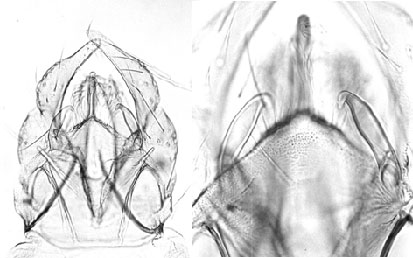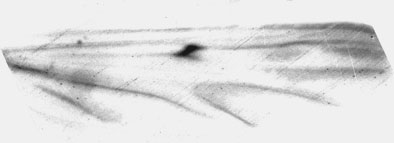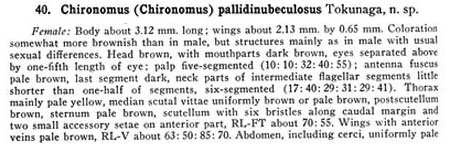Characterized by the patterned wings. This pattern is very similar to that of the African species C. calipterus Kieffer, resulting in the Asian and Australo-Pacific material being synonymised with the African species. However the polytene chromosomes indicate that they are distinct species. There is a precedent from Drosophila for species to show the same wing pattern as a result of independent mutations of the same same gene (Prud´homme et al. 2006.) The name proposed for the Asian and Australo-Pacific material has been C. kiiensis Tokunaga 1936, but COI sequence shows that this is more related to C. striatipennis Kieffer (Pramual et al. 2016) and that Australian material is not the same. P.S. Cranston (unpubl.) had previously suggested that this species matched the description of C. pallidinubeculosus.
Male:
In details below, values for Australian specimens are followed by the range in Micronesia, given in brackets.
Male hypopygium of C. pallidinubeculosus (left) and superior appendage (right)Wings with dark spot over the crossvein and with obvious dark clouds and seams, particularly in cell R5. 17-22 setae in squamal fringe, 2 Scf on branchiolum. Haltere pale.
Wing length 2.44-2.82 (2.07-2.35) mm; width 0.60-0.68 (0.53-0.64) mm; VR 1.02-1.07 (1.04-1.09).

Face yellowish brown, antennae and palps brown. AR about 3.00-3.13 (2.82-2.94). Frontal tubercles quite large, about 15-56 µm long and 10-15 µm wide. 11-19 (16) clypeal setae.
Palps (micron): 45 (40): 48 (40): (136): 161 (136): 234 (200).Thorax yellowish green with brown stripes, lateral stripes darker along the medial edge, and ending in a darker spot; postnotum and sternopleuron brown.
Setae: acrostichals - 9-11; dorsocentrals - 9-11; prealar - 4-5; scutellar in two rows - 2-3 in anterior row, 6-9 in posterior row (total 8-12).
Legs yellow, femur with a dark band just before the knee; tarsal joints darkened. LR 1.61 (1.59-1.630 (1.78-1.94).
Leg lengths (microns) and proportions as follows:
| Fe
| Ti
| Ta1
| Ta2
| Ta3
| Ta4
| Ta5
| LR
| F/T
| Ta5/Ti
|
PI
| 1000
| 915
| 1470
| 800
| 580
| 480
| 235
| 1.59-1.63
| 0.97-1.20
| 2.1-3.0
|
PII
| 1045
| 1050
| 600
| 353
| 265
| 190
| 138
| 0.52-0.63
| 0.98-1.0
| -
|
PIII
| 1150
| 1285
| 985
| 600
| 447
| 273
| 173
| 0.75-0.80
| 0.91-0.93
| -
|
AntTa5 about 0.26-0.30 (0.32) length of Ti. About 7 sensilla chaetica on midTa1, and perhaps 5 on hindTa1.
Abdomen brown, no obvious bands on the segments. 5-6 (14) setae on TIX, probably in a single clear area.
Superior volsella essentially an E-type, perhaps closest to fig. h of Strenzke 1959, but end more sharply curved.
Inferior volsella reaching about to end of the anal point with some setae branched, in Micronesian specimens, this is noted as being unequal.
Style abruptly narrowing at distal third.
Female:

Original description of C. pallidinubeculosus female from Tokunaga 1964Additional data from Paratype female:
Wing length 2.60 mm, width 0.73 mm, VR 0.89. LR not available.
Antennal proportions (µm): 142 : 99 : 114 : 91 : 165. Cephalic tubercles about 390 µm.
Palpal proportions (segs. 2-5) (µm): 40 : 136 : 136 : 170; P5/P4 1.25-1.38; P5/P3 1.38-1.75. 14 clypeal setae.
Thoracic setae: acrostichals - 14; dorsocentrals - abt 22; prealar - at least 2; scutellar in two rows – 5 in anterior row, 8 in posterior row.
2 Scf on branchiolum of wing.
Leg lengths (µm) and proportions as follows:
| Fe
| Ti
| Ta1
| Ta2
| Ta3
| Ta4
| Ta5
| LR
| F/T
| BR
|
PI
| 1040
| 860
| -
| -
| -
| -
|
| -
| 1.21
| -
|
PII
| 1060
| 1060
| 600
| 320
| 250
| 170
| 110
| 0.57
| 1.00
| -
|
PIII
| 1220
| 1320
| -
| -
| -
| -
| -
| 0.92
| -
| -
|
No information available for Australian specimens.




